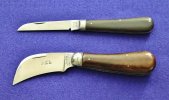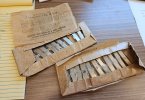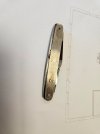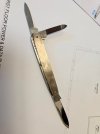- Joined
- Dec 2, 2010
- Messages
- 526
The BladeForums.com 2024 Traditional Knife is available! Price is $250 ea (shipped within CONUS).
Order here: https://www.bladeforums.com/help/2024-traditional/


Lovely collection of desirable Bowies Trubetzkoy. In particular the Ibbotson stands out to me most as I have humble example of a pocketknife of his branded "Slash" iirc. Must dig it out.Some Bowie action:


Left to right: Wragg & Sons, Charles Ibbotson & Co, and unmarked (bot most certainly made in Sheffield too). The Ibbotson is a recent acquisition.
Verah nice Bowie action!Some Bowie action:


Left to right: Wragg & Sons, Charles Ibbotson & Co, and unmarked (bot most certainly made in Sheffield too). The Ibbotson is a recent acquisition.

Looking forward to seeing that pocket knife! This one also has the "Slash" trademark, though there's quite a bit of pitting (nothing deep) on the ricasso.Lovely collection of desirable Bowies Trubetzkoy. In particular the Ibbotson stands out to me most as I have humble example of a pocketknife of his branded "Slash" iirc. Must dig it out.
As I read on him I remembered the account of his hardship as a youngster and his later success and patents on steel handled bowies he exported to the States to protect the exotic handle materials. Yours has Ivory yes?
Perhaps test it for silver, it certainly looks like a high end bowie knife for export such as he was known for with his wrap around handle. Does the blade say "Hunting Knife"? A photo of the markings would be great. Do you own many Bowies? They really are very collectable and command high prices.Looking forward to seeing that pocket knife! This one also has the "Slash" trademark, though there's quite a bit of pitting (nothing deep) on the ricasso.
Yes, I believe it's ivory. The frame, however, I'm not so sure about. It was advertised as nickel silver, and I know of other similar examples using that material. However, it looks more like silver to me (especially with respect to the nickel silver sheath throat), though I see no hallmarks (just the word "patent" on the butt).
Very nice pocket knife! Yes, mine does say "Hunting Knife," though the etching is pretty faded. Here are some close-ups:Perhaps test it for silver, it certainly looks like a high end bowie knife for export such as he was known for with his wrap around handle. Does the blade say "Hunting Knife"? A photo of the markings would be great. Do you own many Bowies? They really are very collectable and command high prices.
Here is the link to my wee Slasher
I've just discovered the search function allows you to narrow the confines to "this thread" which is a hugely helpful tool. I often forget if I've posted a knife to this thread.



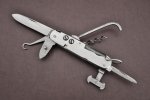
Beautiful harness knife Neal. Wonder if that one would have been produced during the Boer War? BTW holtzapfel is "crabapple" in German. Literally "woodapple". Seems somewhere along the way the Holtzapffels added an F. Must have had crabby ancestors LOL!
Eric
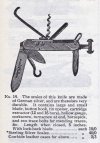





What an historical treasure, Ed!!! Nice folder of "Samples"!!!!Fine 3 blades indeed, which is your pick of the bunch? Card 4, where are the others languishing!
Quite incredible piece of history Ed. Prices were often given for the dozen, or even for the gross, but if these are prices, they're written kind of strangely. Prior to 1971, in Britain, Shillings were on the left, Pennies on the right. So 2/6 (a Half Crown) was 2 Shillings and sixpence, 10/6 (Ten Bob) was 10 Shillings and sixpence. But there were 20 Shillings to the Pound, and after that, prices were written quite differently. My dad was a skilled manual worker, and in the late 60's, earned about £60 a week. I started work in 1977, as an apprentice mechanic, on £18 a week. A loaf of bread in the late 60's was around 1/6. In the mid 70's, after decimalisation, a pint was about 18 (new) pence, or 3/6 in 'old money'. I don't ever remember paying much for pocket knives in Sheffield, but then a lot of them went home in lunchboxes. Even the poorest Sheffielders had good table cutleryLove to note the difference in pricing for scales and pattern presumably.
Can someone better at historic pre decimal interpret the price and suggest an average working mans weekly wage for us garner an idea of relative cost?

